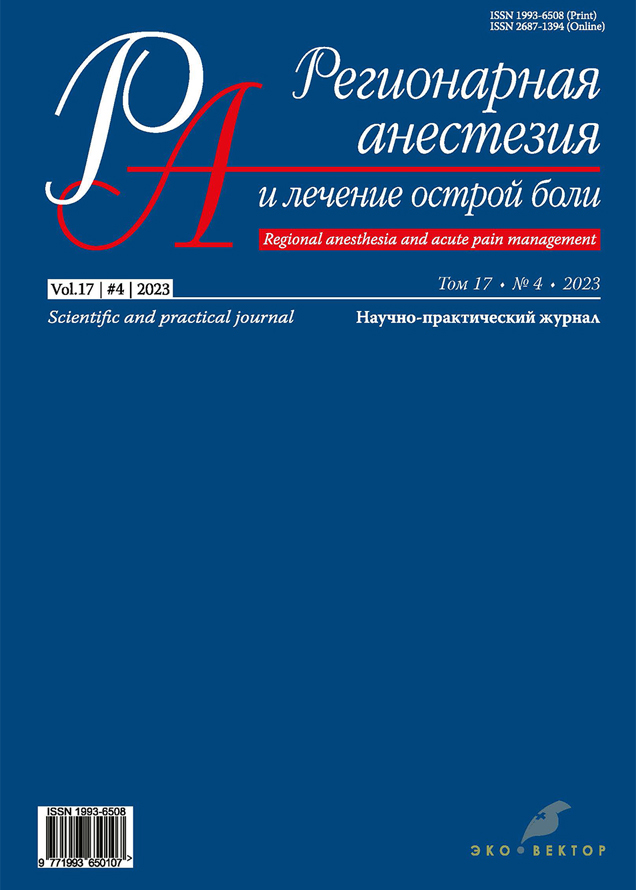Postoperative pain relief quality after cesarean section using a stress monitor (Neon FSC system): prospective single-center randomized clinical comparative study
- Authors: Upryamova E.Y.1, Shifman E.M.2, Degtyarev P.A.3, Snezhko V.D.4, Maksimkina T.A.4
-
Affiliations:
- Research Institute of Obstetrics and Gynecology named after D.O. Ott
- Vladimirsky Moscow Regional Research Clinical Institute
- Botkin City Clinical Hospital
- Moscow Regional Research Institute of Obstetrics and Gynecology
- Issue: Vol 17, No 4 (2023)
- Pages: 267-277
- Section: Original study articles
- Submitted: 12.10.2023
- Accepted: 21.11.2023
- Published: 25.12.2023
- URL: https://rjraap.com/1993-6508/article/view/608168
- DOI: https://doi.org/10.17816/RA608168
- ID: 608168
Cite item
Abstract
BACKGROUND: The objective assessment of pain levels during labor, postpartum period, and effectiveness of analgesic response remains difficult. We suppose that the dynamics of the activity of the sympathetic nervous system by measuring the galvanic skin response may become a promising method for solving this problem.
OBJECTIVE: To evaluate the effectiveness of various multimodal analgesia regimens after cesarean section using the NeonFSC stress monitoring system.
MATERIALS AND METHODS: A prospective single-center clinical comparative study was conducted to evaluate the effectiveness of various postoperative multimodal analgesia regimens in 48 postpartum women who underwent elective cesarean section under spinal anesthesia. For postoperative analgesia, group 1 (n=24) underwent a TAP block, and ketorolac and tramadol were prescribed, and group 2 (n=24) received only ketorolac and tramadol. Randomization was made using the envelope method. The visual analog scale (VAS) and NeonFSC system were used to assess the effectiveness of postoperative pain relief. The observation time was 19–22 h.
RESULTS: The patients were comparable in age, gestational age, physical status, method of pain management and delivery. At baseline and during the 2-h postoperative period, the median and distribution of visual analogue scale pain scores did not show a statistically significant difference between groups. During the study period, the highest level of spectral power of skin conductance (SC) was recorded in group 2. Baseline skin conductance variability (SCV) values were comparable between groups (p >0.001). Lower SCV values were noted in patients of group 1, compared to group 2, at night (p=0.003 vs p <0.001). The median values of the level of total spectral power of skin conductivity (DASS) in patients of group 1 were 1.5–2 times lower, starting from the second hour until the end of observation.
CONCLUSION: The NeonFSC system can be a component of an objective assessment of the effectiveness of analgesia after cesarean section.
Full Text
About the authors
Ekaterina Yu. Upryamova
Research Institute of Obstetrics and Gynecology named after D.O. Ott
Email: katerinaupryamova@gmail.com
ORCID iD: 0000-0002-7057-2149
SPIN-code: 5925-0041
MD, Dr. Sci. (Med.), department head
Russian Federation, Saint PetersburgEfim M. Shifman
Vladimirsky Moscow Regional Research Clinical Institute
Email: eshifman@mail.ru
ORCID iD: 0000-0002-6113-8498
SPIN-code: 4582-8494
MD, Dr. Sci. (Med.), Professor, department professor, vice-president of the All-Russian Public Organization «Federation of Anesthesiologists and Reanimatologists»
Russian Federation, MoscowPavel A. Degtyarev
Botkin City Clinical Hospital
Email: p.degtyarev@mail.ru
ORCID iD: 0000-0003-1613-3476
SPIN-code: 4120-1753
clinical resident
Russian Federation, MoscowVera D. Snezhko
Moscow Regional Research Institute of Obstetrics and Gynecology
Email: Verullia@list.ru
ORCID iD: 0000-0001-6623-9637
SPIN-code: 3326-8726
anesthesiologist-resuscitator
Russian Federation, MoscowTatyana A. Maksimkina
Moscow Regional Research Institute of Obstetrics and Gynecology
Author for correspondence.
Email: tatianazob@mail.ru
ORCID iD: 0009-0000-4100-2115
anesthesiologist-resuscitator
Russian Federation, MoscowReferences
- Carvalho B, Cohen SE. Measuring the labor pain experience: delivery still far off. Int J Obstet Anesth. 2013;22(1):6–9. doi: 10.1016/j.ijoa.2012.10.002
- Tournaire M, Theau-Yonneau A. Complementary and Alternative Approaches to Pain Relief During Labor. Evid Based Complement Alternat Med. 2007;4(4):409–417. doi: 10.1093/ecam/nem012
- Theodoros A. Electrodermal activity: Applications in perioperative care. Int J Med Res Health Sci. 2014;3(3):687–695. doi: 10.5958/2319-5886.2014.00418.4
- Burton AR, Birznieks I, Spaak J, et al. Effects of deep and superficial experimentally induced acute pain on skin sympathetic nerve activity in human subjects. Exp Brain Res. 2009;195(2):317–324. doi: 10.1007/s00221-009-1790-9
- Nickel MM, May ES, Tiemann L, et al. Autonomic responses to tonic pain are more closely related to stimulus intensity than to pain intensity. Pain. 2017;158(11):2129–2136. doi: 10.1097/j.pain.0000000000001010
Supplementary files












